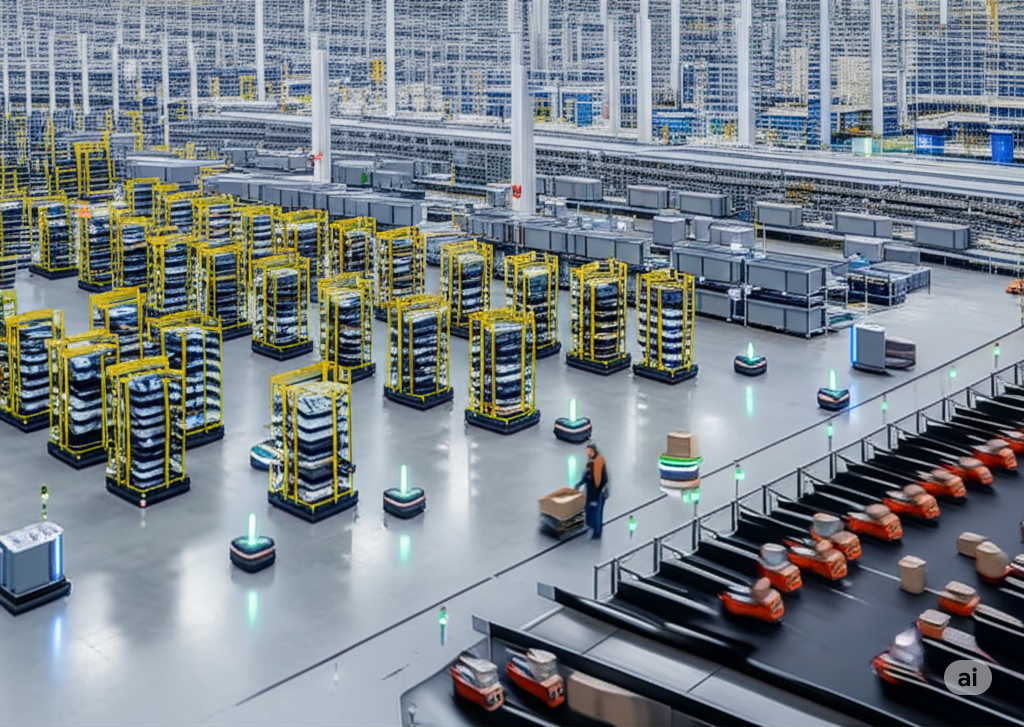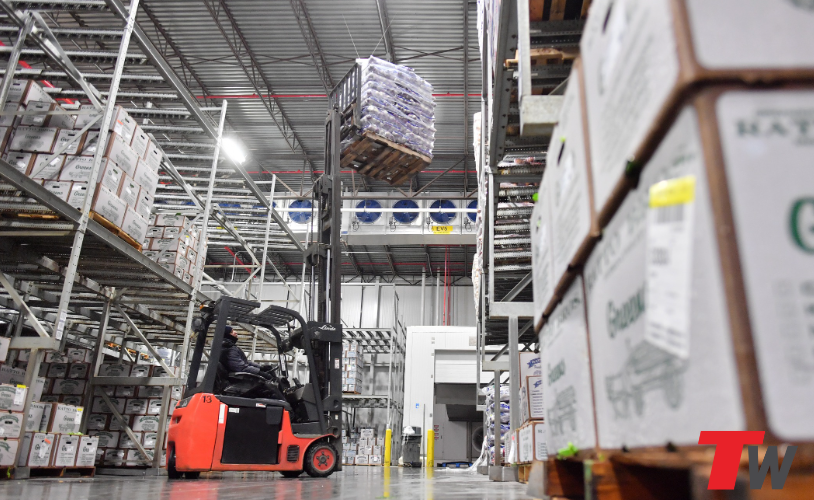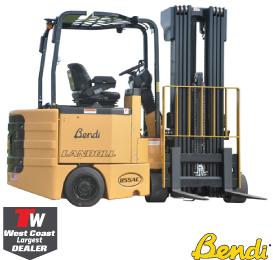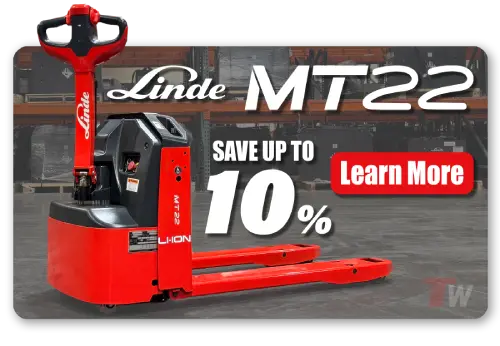Key Takeaways:
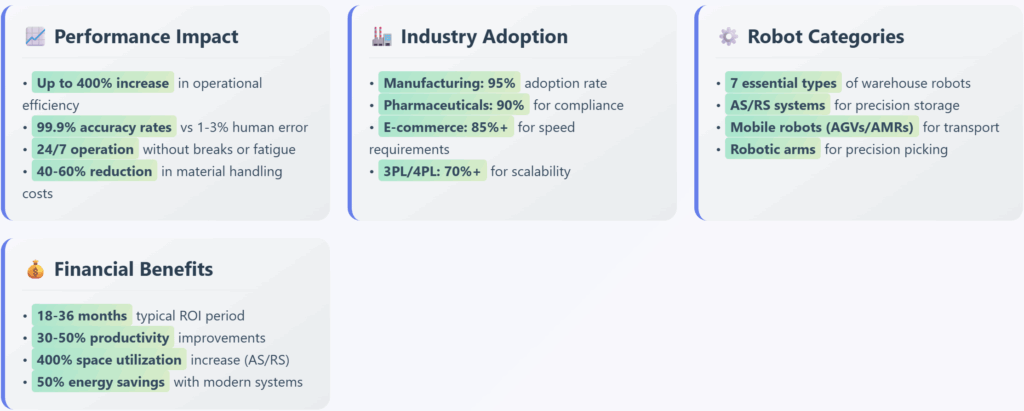
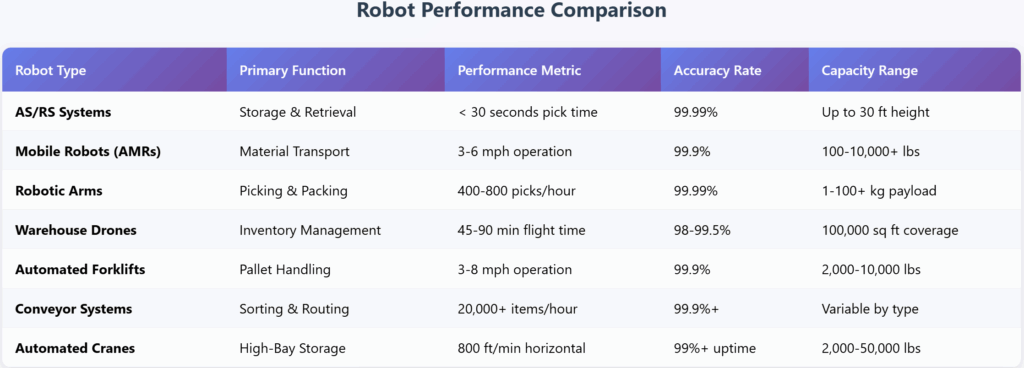
Did you know that warehouse automation robots can increase operational efficiency by up to 400%? I learned this the hard way after spending years watching my team struggle with manual processes that these mechanical marvels could handle in minutes. After two decades in logistics management, I’ve witnessed firsthand how warehouse robots have completely transformed the industry. What started as simple conveyor belts has evolved into sophisticated autonomous systems that make human workers more productive rather than replacing them entirely.
Understanding Warehouse Robotics: The Foundation of Modern Logistics
Warehouse robotics represents the integration of robotic technology and automation systems designed to handle movement, organization, and management of goods. These systems don’t just move boxes around – they’re the backbone of modern supply chains.
Core Functions of Automated Warehouse Robotics
Modern warehouse automation robots handle four primary functions:
- Material transportation – Moving goods efficiently throughout facilities
- Storage optimization – Maximizing space utilization through intelligent placement
- Order fulfillment – Picking, packing, and preparing shipments
- Inventory management – Real-time tracking and cycle counting
- FAQ: What’s the difference between warehouse robots and traditional automation? Traditional automation follows fixed paths and processes, while modern warehouse robots use AI and sensors to adapt to changing conditions and make autonomous decisions.
- FAQ: How reliable are warehouse robots compared to human workers? Quality robots typically achieve 99.9% accuracy rates and can operate 24/7 without breaks, significantly outperforming human consistency in repetitive tasks.
The 7 Essential Types of Mobile Industrial Robots Transforming Warehouses
1. AS/RS (Automated Storage and Retrieval Systems)
AS/RS systems represent the most sophisticated kind of robots in modern warehouses and their precision is incredible. They manage densely packed inventory bins with millimeter accuracy, retrieving specific items from towers that can reach 30 feet high. What really impressed me was watching them work during peak season – no stress, no fatigue, just consistent performance hour after hour.
Key Highlights:
- Space utilization improvement: Up to 400% increase in storage density
- Retrieval speed: Average pick times under 30 seconds
- Accuracy rates: 99.99% with proper calibration
- Energy efficiency: 50% less power consumption than traditional systems
- FAQ: How do AS/RS robots handle inventory that’s buried deep in the system? Advanced algorithms prioritize frequently accessed items near the top, while less common SKUs are stored deeper. The system continuously optimizes placement based on demand patterns.
- FAQ: What happens if an AS/RS robot breaks down? Most systems have redundant robots and can reroute tasks automatically. Critical systems typically maintain 20-30% extra capacity to handle peak loads and equipment maintenance.
2. Industrial Mobile Robots: AGVs and AMRs
The mobile robot category includes both Automated Guided Vehicles (AGVs) and Autonomous Mobile Robots (AMRs). Here’s where I made another expensive mistake early in my career – I confused the two and bought AGVs when we needed AMRs for our flexible operation.
AGVs follow predetermined paths like invisible trains, while AMRs navigate autonomously using advanced sensors and mapping technology. The difference became painfully obvious when we needed to reconfigure our warehouse layout – the AGVs required expensive track modifications, while AMRs just adapted automatically.
These warehouse automation robots excel in material handling and inventory management. I’ve watched AMRs navigate around obstacles, communicate with each other to avoid traffic jams, and even return to charging stations when their batteries run low.
- Load capacity: Ranges from 100 to 10,000+ pounds depending on model
- Operating speed: 3-6 mph for safety in mixed human-robot environments
- Battery life: 8-16 hours of continuous operation
- Integration capability: Works with WMS, ERP, and IoT systems
- FAQ: Can mobile robots work safely around human workers? Modern AMRs use LIDAR, cameras, and proximity sensors to detect and avoid humans. They’re programmed to stop immediately if someone enters their path.
- FAQ: How do mobile robots handle elevator travel between floors? Advanced AMRs can interface with elevator control systems, calling elevators and selecting floors automatically for multi-level operations.
3. Robotic Arms: The Precision Specialists
Robotic arms represent the most versatile different types of robots in warehouse operations. Also known as robotic manipulators or pick-and-place robots, these have multiple joints and specialized end-effectors.
The learning curve for robotic arms can be steep. I remember spending weeks fine-tuning grip pressure for a cosmetics client – too gentle and products slipped, too firm and packaging got damaged. Getting that balance right requires patience and lots of testing.
These precision instruments improve order fulfillment speed and accuracy dramatically. Modern systems can handle items ranging from delicate electronics to heavy automotive parts, switching between tasks with different end-effectors.
- Payload capacity: From 1 kg to 100+ kg depending on model • Reach: 500mm to 3,000mm working radius • Repeatability: ±0.02mm for high-precision applications • Programming options: Teach pendant, offline programming, or AI learning
FAQ: How do robotic arms identify different products for picking? They use vision systems with cameras and AI to recognize products by shape, size, color, and barcode scanning. Advanced systems can even handle random bin picking.
FAQ: What maintenance do robotic arms require? Regular lubrication, sensor calibration, and wear part replacement. Most systems need 2-4 hours of maintenance per month with proper care.
4. Warehouse Drones: The Aerial Advantage
Drones have gained serious traction in warehouse robotics for inventory management and surveillance. I was skeptical about drones until I saw them in action at a 2-million-square-foot distribution center. These flying robots completed a full cycle count in 4 hours that would take humans 3 weeks.
The aerial surveillance capabilities are game-changing for large facilities. Drones can monitor vast warehouse spaces, perform inventory checks in high locations, and even inspect building infrastructure for maintenance issues.
- Flight time: 45-90 minutes depending on payload and conditions • Inventory scanning: Can read barcodes and RFID tags at heights up to 40 feet • Coverage area: Up to 100,000 square feet per flight • Data collection: High-resolution imagery, thermal sensing, gas detection
The biggest challenge with warehouse drones is managing air traffic when multiple units operate simultaneously. Advanced flight management systems coordinate movements to prevent collisions and optimize coverage patterns.
FAQ: Are drones safe to operate in warehouses with workers present? Modern warehouse drones have multiple safety systems including obstacle avoidance, emergency landing protocols, and restricted flight zones around work areas.
FAQ: How accurate is drone-based inventory counting? Properly calibrated systems achieve 98-99% accuracy for visible inventory, with some advanced models reaching 99.5% through AI-enhanced image recognition.
5. Automated Forklifts: Heavy-Duty Automation
Automated forklifts represent the evolution of traditional material handling equipment into autonomous warehouse robots. These machines handle pallet loading and unloading without human operators.
I learned the importance of proper safety protocols the hard way when implementing automated forklifts. Unlike smaller robots, these machines weigh several tons and can cause serious damage if safety systems fail. Proper zone management and emergency stops are absolutely critical.
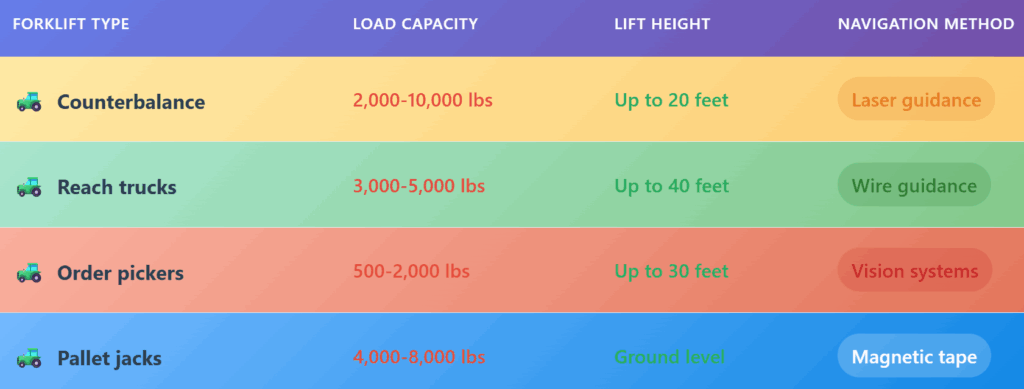
These autonomous systems navigate predefined paths or use advanced vision systems for flexible operations. The integration with warehouse management systems allows for dynamic task assignment and real-time optimization.
- Operating speed: 3-8 mph depending on load and environment • Precision: ±10mm positioning accuracy for pallet placement • Safety features: 360-degree sensors, emergency stops, collision avoidance • Battery life: 8-12 hours of continuous operation
FAQ: How do automated forklifts handle unexpected obstacles? They use sensor arrays including LIDAR, cameras, and ultrasonic sensors to detect obstacles and either navigate around them or stop safely until the path clears.
FAQ: What’s the ROI timeline for automated forklifts? Most operations see payback within 18-24 months through reduced labor costs, improved utilization, and decreased product damage.
6. Conveyor Systems: The Foundation of Flow
While conveyor systems might seem old-school compared to other kinds of robots, modern installations are highly sophisticated automated systems. These aren’t your grandfather’s assembly lines – today’s conveyors integrate sensors, AI, and dynamic routing capabilities.
The variety of conveyor configurations is impressive. Belt conveyors handle bulk materials, roller conveyors manage boxes and packages, while sortation systems direct items to specific destinations based on real-time data.
I remember implementing a sortation system that could handle 15,000 packages per hour with 99.95% accuracy. Watching packages zip through dozens of decision points without a single misdirection was like observing a mechanical ballet.
| Conveyor Type | Speed Range | Load Capacity | Best Applications |
| Belt conveyors | 50-500 ft/min | 50-500 lbs/ft | Bulk materials, loose items |
| Roller conveyors | 100-400 ft/min | 25-100 lbs/ft | Boxes, packages, totes |
| Chain conveyors | 25-200 ft/min | 500+ lbs/ft | Heavy pallets, automotive |
| Sortation systems | 300-600 ft/min | 1-150 lbs | Package distribution |
Modern conveyor technologies integrate seamlessly with other warehouse automation robots. They serve as the circulatory system that connects picking stations, packing areas, and shipping docks.
- Throughput capacity: Up to 20,000+ items per hour for high-speed sortation • Accuracy rates: 99.9%+ with proper maintenance and calibration • Energy efficiency: Variable speed drives reduce power consumption by 30-50% • Maintenance requirements: 4-8 hours per week for large systems
FAQ: How do modern conveyors handle different package sizes and weights? Advanced systems use dynamic weighing, dimensioning, and vision systems to automatically adjust speed and routing based on each item’s characteristics.
FAQ: Can conveyor systems adapt to changing warehouse layouts? Modular conveyor designs allow for reconfiguration, though major layout changes may require significant modifications compared to mobile robot solutions.
7. Automated Cranes: Vertical Powerhouses
Automated cranes dominate high-bay warehouses where vertical space optimization is critical. These towering machines represent the pinnacle of heavy-duty warehouse robotics, capable of moving and stacking goods up to 150 feet high.
The precision of modern automated cranes is remarkable. I’ve watched them place 2,000-pound pallets with millimeter accuracy in storage locations 12 stories above the ground. The engineering required to achieve this level of precision while handling such massive loads is truly impressive.
| Crane Configuration | Lift Capacity | Maximum Height | Typical Applications |
| Single-mast cranes | 2,000-5,000 lbs | Up to 100 feet | Standard pallet storage |
| Double-mast cranes | 5,000-15,000 lbs | Up to 150 feet | Heavy industrial items |
| Mini-load cranes | 50-500 lbs | Up to 80 feet | Small parts, electronics |
| Specialized cranes | 1,000-50,000 lbs | Custom heights | Automotive, aerospace |
These automated systems optimize vertical space utilization and minimize manual labor in high-density storage applications. The ROI calculation for automated cranes is often compelling because they maximize cubic storage capacity without expanding the building footprint.
- Positioning accuracy: ±2mm horizontal, ±5mm vertical • Travel speeds: Up to 800 ft/min horizontal, 200 ft/min vertical • Duty cycle: 24/7 operation with 99%+ uptime when properly maintained • Integration: Full WMS connectivity for real-time inventory management
FAQ: How do automated cranes handle earthquake safety in seismic zones? Modern installations include seismic sensors that automatically park cranes in safe positions and secure loads when detecting ground motion above threshold levels.
FAQ: What happens during power outages with loaded cranes? Battery backup systems provide enough power for safe load placement and crane parking. UPS systems typically provide 15-30 minutes of emergency operation.
Critical Tasks That Different Types of Robots Handle
| Task Category | Primary Robot Types | Performance Metrics |
| Material Transportation | Mobile robots, conveyors | 2,000-15,000 moves/day |
| Picking Operations | Robotic arms, AS/RS | 300-1,200 picks/hour |
| Sorting & Routing | Sortation conveyors, AMRs | 99.9%+ accuracy rates |
| Palletizing Tasks | Robotic arms, automated cranes | 400-800 pallets/day |
| Inventory Management | Drones, mobile robots | Real-time visibility |
Material Transportation Excellence
The transportation capabilities of modern warehouse robots still amaze me after all these years. Cube storage robots, AGVs, and AMRs form the circulatory system of automated facilities, moving materials with efficiency that humans simply cannot match.
I’ve calculated that these systems reduce material handling costs by 40-60% while improving accuracy. The real breakthrough came when I realized that autonomous warehouse robots don’t just replace human labor – they create new possibilities for workflow optimization.
- Transport capacity: 50 to 5,000+ pounds depending on robot type • Speed optimization: Dynamic routing reduces travel time by 25-35% • Energy efficiency: Smart scheduling minimizes empty travel • Integration: Real-time coordination with inventory management systems
Precision Picking and Packing
Robotic arms equipped with advanced vision systems have revolutionized order fulfillment. The accuracy improvements are staggering – error rates drop from 1-3% with manual picking to 0.01% with properly configured robotic systems.
The speed improvements are equally impressive. While human pickers might handle 100-150 items per hour, robotic arms consistently achieve 400-800 picks per hour with zero fatigue.
FAQ: How do robots handle fragile or irregularly shaped items? Advanced gripping technology including soft robotics and adaptive fingers can handle delicate items like eggs or complex shapes like tools and hardware.
FAQ: What’s the learning curve for implementing robotic picking? Initial setup and training typically takes 4-8 weeks, but systems continue improving through machine learning algorithms that adapt to new products and conditions.
Industries Leading Warehouse Robot Adoption
| Industry Sector | Adoption Rate | Primary Robot Types | Key Drivers |
| E-commerce | 85%+ | AS/RS, mobile robots, robotic arms | Order volume, speed requirements |
| 3PL/4PL Logistics | 70%+ | Conveyors, mobile robots, automated cranes | Labor costs, scalability |
| Grocery/Food | 60%+ | Automated forklifts, conveyors, drones | Temperature control, throughput |
| Pharmaceuticals | 90%+ | AS/RS, robotic arms, mobile robots | Compliance, contamination control |
| Manufacturing | 95%+ | All types | Productivity, quality control |
E-commerce Revolution
The e-commerce boom has been the primary catalyst for warehouse robotics adoption. Online retailers process millions of individual orders with delivery expectations that manual systems cannot meet.
I’ve worked with e-commerce clients who went from processing 10,000 orders per day manually to handling 100,000+ orders with automated systems. The transformation isn’t just about speed – it’s about consistency and scalability.
Pharmaceutical Precision
The pharmaceutical industry demands the highest levels of accuracy and contamination control. Robotic systems excel in these environments because they eliminate human contact with sterile products and provide complete traceability.
FAQ: How do warehouse robots handle pharmaceutical cold chain requirements? Specialized robots operate in temperature-controlled environments down to -80°C, with integrated monitoring systems that track temperature exposure throughout the handling process.
FAQ: What regulatory compliance do pharmaceutical robots need? Systems must meet FDA 21 CFR Part 11 requirements for electronic records, GMP standards for manufacturing, and specific validation protocols for pharmaceutical applications.
How Robotics in Logistics Is Transforming Operations
The impact of robotics in logistics extends far beyond simple automation. These systems are creating entirely new operational paradigms that were impossible with manual processes.
Operational Hour Extensions
One of the most significant advantages I’ve observed is the ability to extend operational hours. Robots work overnight shifts without fatigue, effectively doubling or tripling warehouse capacity without expanding physical infrastructure.
The strategic implications are huge. Peak season demand that once required temporary staffing can now be handled by existing robotic systems working extended hours.
- 24/7 operation capability: Robots don’t need breaks, vacations, or shift changes • Consistent performance: No productivity decline during night shifts • Maintenance scheduling: Planned downtime during low-demand periods • Energy optimization: Off-peak power rates reduce operational costs
Task Redistribution Strategy
The most successful robotics implementations don’t just replace humans – they redistribute tasks to optimize both human and robotic capabilities. Robots handle repetitive, physically demanding tasks while humans focus on problem-solving and exception handling.
This collaboration model has produced remarkable results. I’ve seen facilities achieve 30-50% productivity improvements while actually improving job satisfaction for human workers.
FAQ: Do warehouse robots eliminate jobs or create new opportunities? While robots reduce demand for manual labor, they create new positions in robot maintenance, programming, and system optimization. The net effect varies by implementation.
FAQ: How do workers adapt to working alongside robots? Most workers adapt quickly when properly trained. The key is emphasizing collaboration rather than replacement, with robots handling dangerous or repetitive tasks.
Integration Capabilities and System Synergies
System Integration Mastery
The magic happens when different types of robots work together seamlessly. I’ve designed systems where AS/RS robots retrieve items, mobile robots transport them to picking stations, robotic arms handle individual picks, and conveyors route finished orders.
The coordination required is incredibly complex. Every robot must communicate its status, location, and intentions to prevent conflicts and optimize workflow. Advanced warehouse management systems orchestrate this mechanical symphony.
Future Integration Trends
The next frontier in warehouse robotics involves AI-driven predictive analytics. Systems that can anticipate demand patterns, predict maintenance needs, and optimize operations in real-time represent the future of logistics automation.
FAQ: How do different robot brands integrate with each other? Modern systems use standardized communication protocols, though integration complexity varies. Some combinations require custom middleware for seamless operation.
FAQ: What’s the biggest challenge in multi-robot integration? Traffic management and task coordination become exponentially complex as robot density increases. Advanced scheduling algorithms are essential for large-scale operations.
Implementation Strategies and Best Practices
After managing dozens of robotics implementations, I’ve learned that success depends more on planning and change management than on the technology itself. The most sophisticated robots fail without proper integration strategy.
Phased Implementation Approach
My recommendation is always to start small and scale systematically. Begin with a single application, learn from the experience, then expand to additional areas. This approach minimizes risk and allows for optimization before major investments.
- Phase 1: Pilot implementation in controlled environment (3-6 months) • Phase 2: Expand to similar applications with lessons learned (6-12 months) • Phase 3: Full-scale deployment across multiple functions (12-24 months) • Phase 4: Advanced optimization and AI integration (ongoing)
Change Management Considerations
The human element is often the most challenging aspect of robotics implementation. Workers may feel threatened, management may have unrealistic expectations, and operations teams struggle with new maintenance requirements.
Clear communication about goals, training programs, and career development paths are essential for successful adoption. I’ve seen technically perfect installations fail because the human side wasn’t properly managed.
FAQ: What’s the typical payback period for warehouse robots? Most implementations achieve ROI within 18-36 months, depending on labor costs, operational complexity, and utilization rates.
FAQ: How do you measure the success of a robotics implementation? Key metrics include throughput improvement, accuracy rates, labor cost reduction, safety incidents, and system uptime. Baseline measurements before implementation are crucial.
Future Trends and Emerging Technologies
Artificial Intelligence Integration
The convergence of AI and robotics is creating possibilities I couldn’t have imagined even five years ago. Vision systems that can identify damaged products, predict maintenance needs, and optimize operations in real-time are becoming standard features.
Machine learning algorithms continuously improve performance by analyzing operational data. These systems literally get smarter every day, adapting to changing conditions and optimizing their own performance.
Collaborative Evolution
The future belongs to collaborative systems where humans and robots work as integrated teams. Advanced cobots will handle routine tasks while humans manage exceptions, maintenance, and strategic decisions.
FAQ: How will 5G connectivity change warehouse robotics? 5G enables real-time coordination of hundreds of robots simultaneously, supporting more complex choreography and instantaneous response to changing conditions.
FAQ: What role will quantum computing play in warehouse optimization? Quantum algorithms could solve complex routing and scheduling problems that are currently computationally impossible, potentially revolutionizing large-scale operations.
Conclusion: The Automated Future of Warehousing
Looking back over two decades in logistics, the transformation brought by warehouse robots has exceeded every prediction I made. These autonomous warehouse robots haven’t just automated tasks – they’ve created entirely new possibilities for efficiency, accuracy, and scalability.
The seven different types of robots we’ve explored – from AS/RS systems to automated cranes – represent mature technologies that deliver measurable results. The question isn’t whether to implement robotics in logistics, but how quickly you can adapt to remain competitive.
My strongest recommendation is to start your automation process now. Begin with pilot projects, learn from early implementations, and scale systematically. The companies that wait for “perfect” solutions will find themselves at a permanent disadvantage.
The future of warehousing is collaborative, intelligent, and remarkably efficient. Warehouse automation robots will continue evolving, but the fundamental advantages – 24/7 operation, consistent accuracy, and scalable capacity – make them indispensable for modern logistics.
